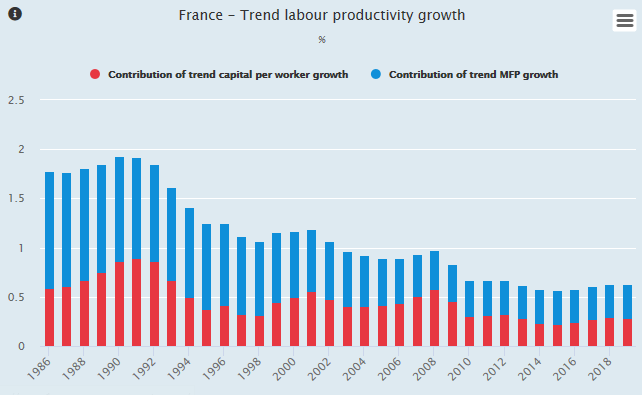Productivity Profile of France
 Organisations
Organisations
Conseil National de Productivité (CNP)
Conseil d’Analyse Économique (CAE)
 Selected Publications
Selected Publications
CNP: Dynamiques sectorielles et gains de productivité (2022), The role of human capital in the productivity slowdown in France (2021), Explorer les liens entre mixité et productivité dans les entreprises (2021), Quelle place pour les compétences dans l’entreprise? (2021), A new approach to skills mismatch (2021), The effects of the Covid-19 crisis on productivity and competitiveness (2021), Productivity and competitiveness: where does France stand in the Euro zone? (2019);
Banque de France: News from the Frontier: Increased Productivity Dispersion across Firms and Factor Reallocation (2021), Productivity Slowdown, Tax Havens and MNEs’ Intangibles: where is Measured Value Creation? (2021), The impact of ICTs and digitalization on productivity and labor share: Evidence from French firms (2020);
Institut National de la Statistique et des Études Économiques (INSEE): La situation de l’appareil productif français avant la crise sanitaire de la Covid‑19 (2021), La productivité en France de 2000 à 2015 : poursuite du ralentissement et hausse modérée de la dispersion entre entreprises (2019).
 Data
Data
Click here to access our Compare-Your-Country tool and explore productivity data from the GFP member countries.

 Latest OECD Recommendations
Latest OECD Recommendations
The level of productivity is high, but productivity growth has been weak for several decades. Strengthening the quality assurance and guidance systems for lifelong learning would help foster the inclusion of low-skilled workers and their productivity. Continuing to improve equity and quality of initial education would strengthen skills and productivity growth. Easing entry into a wider range of regulated professions would enhance competition and productivity, thereby lowering prices to the benefit of consumers, especially poor ones.
- Strengthen the quality assurance and guidance systems for lifelong learning, to help foster the inclusion of low-skilled workers and their productivity;
- Continue to improve equity and quality of initial education;
- By continuing to reduce class size for other grades in disadvantaged neighbourhoods;
- By promoting innovative practices in teacher training to meet the different needs of pupils;
- By continuing to increase universities’ autonomy over their programmes and human resource policies, while taking into account their public service function.
- Ease entry into a wider range of regulated professions (entry barriers and quotas) to enhance competition.
Related Documents


